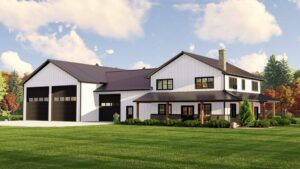
Published in the Anchorage Daily News 9.27.23
A barn? A condo? A single family home? Or all of the above? It’s called a Barndominium. I’ve had a hard time spelling it and even saying it. But it is the latest new trend in housing and growing in popularity around the nation and in Alaska. I first heard about it sitting around a small conference table with a builder and a young couple talking about their housing needs. The husband wanting a huge garage for a variety of reasons and his spouse wanted a smaller, simpler home to raise their two young girls. And the builder said, “Oh, you’re talking about a Barndominium.” A what? And so the plan emerged and the ‘Barndo’ is now under construction.
Our diverse and multi-generational population is asking for and creating all new concepts for housing —from the tiny house to the Barndo (easier to say and spell) to the unit lot subdivision. Savvy builders and developers need to pay attention to all these emerging lifestyles as well as public planners. Developers have old fashioned concepts. For example, the requirements that a secondary building on a lot only be no larger than the first floor of the primary residence. Or the requirement in a single-family subdivision that the square footage of the residential portion of the home must be a minimum of a specific square footage. Assembly members Meg Zaletel and Kevin Cross may be on the right track about paring down the fifteen residential zoning requirements, although it is my opinion that the existing zoning of a development should remain intact as identified in the CCR’s of that particular home community. The lopsided Barndo where the garage/warehouse is larger than the living area will definitely be a challenge for appraisers who always give living square footage more than two or three times the value of the garage. Most appraisers value a garage at $100 per square foot, even if the construction is the same except for flooring. Barndos garages all have water/sewer/electrical/heating, and most have textured and painted walls, albeit few walls which represents the primary feature of a Barndo. Its’ primary identity is “I can create a wood working shop, a basketball court, storage for my six 1950s Chevrolets, my snow machines and my motorhome. I can stop paying storage fees and can tinker with anything with an engine without having to drive to a garage town.”
This lopsided value will affect residential mortgage financing. Unfortunately, appraisers, due to their rules and regulations, look at historical data, either closed or pended, and are unable to take into account rapid changes in the housing market. I was recently told by a residential builder that the planning department at the MOA was charging $12,000 for a permit for a 2,500 square foot home. I can only imagine what the cost might be for a Barndo which are typically much larger. Any time there is a new housing concept appraisers, mortgage investors, and local officials create a plethora of red flags. Let’s hope that does not happen to the Barndo (so much easier to say). COVID and its residual social changes has impacted the way we think about not only where and how we work but also our housing lifestyle.

 Connie Yoshimura is the Owner and Broker of Berkshire Hathaway HomeServices Alaska Realty. With over 40 years of residential real estate experience, she continues to be a leader in Alaska’s housing market. Most recently, she sold the highest-priced home ever recorded in the Alaska MLS.
Connie Yoshimura is the Owner and Broker of Berkshire Hathaway HomeServices Alaska Realty. With over 40 years of residential real estate experience, she continues to be a leader in Alaska’s housing market. Most recently, she sold the highest-priced home ever recorded in the Alaska MLS.
Leave a Reply